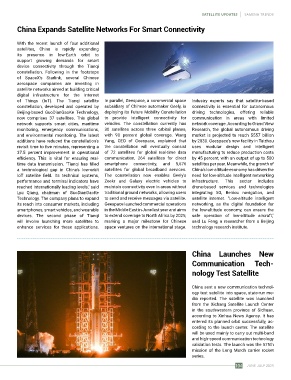Page 104 - SAMENA Trends - June-July 2025
P. 104
SATELLITE UPDATES SAMENA TRENDS
China Expands Satellite Networks For Smart Connectivity
With the recent launch of four additional
satellites, China is rapidly expanding
its presence in low-Earth orbit to
support growing demands for smart
device connectivity through the Tianqi
constellation. Following in the footsteps
of SpaceX's Starlink, several Chinese
aerospace companies are investing in
satellite networks aimed at building critical
digital infrastructure for the Internet
of Things (IoT). The Tianqi satellite In parallel, Geespace, a commercial space Industry experts say that satellite-based
constellation, developed and operated by subsidiary of Chinese automaker Geely, is connectivity is essential for autonomous
Beijing-based GuoDianGaoKe Technology, deploying its Future Mobility Constellation driving technologies, offering reliable
now comprises 37 satellites. This global to provide intelligent connectivity for communication in areas with limited
network supports smart cities, maritime vehicles. The constellation currently has network coverage. According to Grand View
monitoring, emergency communications, 30 satellites across three orbital planes, Research, the global autonomous driving
and environmental monitoring. The latest with 90 percent global coverage. Wang market is projected to reach $557 billion
additions have reduced the constellation's Yang, CEO of Geespace, explained that by 2030. Geespace's new facility in Taizhou
revisit time to five minutes, representing a the constellation will eventually consist uses modular design and intelligent
37.5 percent improvement in operational of 72 satellites for global real-time data manufacturing to reduce production costs
efficiency. This is vital for ensuring real- communication, 264 satellites for direct by 45 percent, with an output of up to 500
time data transmission. "Tianqi has filled smartphone connectivity, and 5,676 satellites per year. Meanwhile, the growth of
a technological gap in China's low-orbit satellites for global broadband services. China's low-altitude economy has driven the
IoT satellite field. Its technical systems, The constellation now enables Geely's need for low-altitude intelligent networking
performance and terminal indicators have Zeekr and Galaxy electric vehicles to infrastructure. This sector includes
reached internationally leading levels," said maintain connectivity even in areas without drone-based services and technologies
Lyu Qiang, chairman of GuoDianGaoKe traditional ground networks, allowing users integrating 5G, Beidou navigation, and
Technology. The company plans to expand to send and receive messages via satellite. satellite internet. "Low-altitude intelligent
its reach into consumer markets, including Geespace launched commercial operations networking, as the digital foundation for
smartphones, smart vehicles, and wearable in the Middle East in June last year and aims the low-altitude economy, can ensure the
devices. The second phase of Tianqi to extend coverage to North Africa by 2025, safe operation of low-altitude aircraft,"
will involve launching more satellites to marking a major milestone for Chinese said Lu Feng, a researcher from a Beijing
enhance services for these applications. space ventures on the international stage. technology research institute.
China Launches New
Communication Tech-
nology Test Satellite
China sent a new communication technol-
ogy test satellite into space, state-run me-
dia reported. The satellite was launched
from the Xichang Satellite Launch Center
in the southwestern province of Sichuan,
according to Xinhua News Agency. It has
entered its planned orbit successfully, ac-
cording to the launch center. The satellite
will be used mainly to carry out multi-band
and high-speed communication technology
validation tests. The launch was the 575th
mission of the Long March carrier rocket
series.
104 JUNE-JULY 2025

